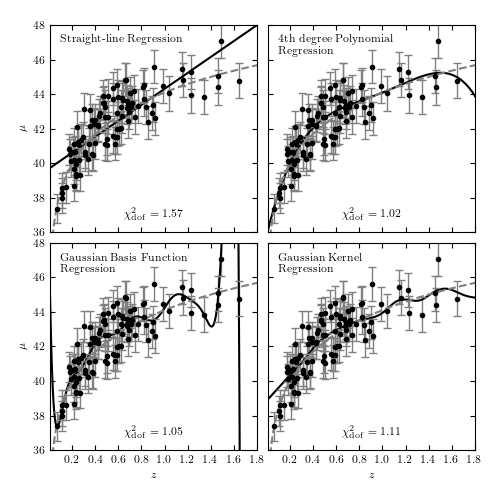Cosmology Regression Example¶
Figure 8.2
Various regression fits to the distance modulus vs. redshift relation for a
simulated set of 100 supernovas, selected from a distribution
![p(z) \propto (z/z_0)^2 \exp[(z/z_0)^{1.5}]](../../_images/math/66e811d729911b77f7e456662f18600584352918.png) with
with  .
Gaussian basis functions have 15 Gaussians evenly spaced between z = 0 and 2,
with widths of 0.14. Kernel regression uses a Gaussian kernel with width 0.1.
.
Gaussian basis functions have 15 Gaussians evenly spaced between z = 0 and 2,
with widths of 0.14. Kernel regression uses a Gaussian kernel with width 0.1.

# Author: Jake VanderPlas
# License: BSD
# The figure produced by this code is published in the textbook
# "Statistics, Data Mining, and Machine Learning in Astronomy" (2013)
# For more information, see http://astroML.github.com
# To report a bug or issue, use the following forum:
# https://groups.google.com/forum/#!forum/astroml-general
import numpy as np
from matplotlib import pyplot as plt
from astropy.cosmology import LambdaCDM
from astroML.datasets import generate_mu_z
from astroML.linear_model import (LinearRegression, PolynomialRegression,
BasisFunctionRegression, NadarayaWatson)
#----------------------------------------------------------------------
# This function adjusts matplotlib settings for a uniform feel in the textbook.
# Note that with usetex=True, fonts are rendered with LaTeX. This may
# result in an error if LaTeX is not installed on your system. In that case,
# you can set usetex to False.
if "setup_text_plots" not in globals():
from astroML.plotting import setup_text_plots
setup_text_plots(fontsize=8, usetex=True)
#------------------------------------------------------------
# Generate data
z_sample, mu_sample, dmu = generate_mu_z(100, random_state=0)
cosmo = LambdaCDM(H0=70, Om0=0.30, Ode0=0.70, Tcmb0=0)
z = np.linspace(0.01, 2, 1000)
mu_true = cosmo.distmod(z)
#------------------------------------------------------------
# Define our classifiers
basis_mu = np.linspace(0, 2, 15)[:, None]
basis_sigma = 3 * (basis_mu[1] - basis_mu[0])
subplots = [221, 222, 223, 224]
classifiers = [LinearRegression(),
PolynomialRegression(4),
BasisFunctionRegression('gaussian',
mu=basis_mu, sigma=basis_sigma),
NadarayaWatson('gaussian', h=0.1)]
text = ['Straight-line Regression',
'4th degree Polynomial\n Regression',
'Gaussian Basis Function\n Regression',
'Gaussian Kernel\n Regression']
# number of constraints of the model. Because
# Nadaraya-watson is just a weighted mean, it has only one constraint
n_constraints = [2, 5, len(basis_mu) + 1, 1]
#------------------------------------------------------------
# Plot the results
fig = plt.figure(figsize=(5, 5))
fig.subplots_adjust(left=0.1, right=0.95,
bottom=0.1, top=0.95,
hspace=0.05, wspace=0.05)
for i in range(4):
ax = fig.add_subplot(subplots[i])
# fit the data
clf = classifiers[i]
clf.fit(z_sample[:, None], mu_sample, dmu)
mu_sample_fit = clf.predict(z_sample[:, None])
mu_fit = clf.predict(z[:, None])
chi2_dof = (np.sum(((mu_sample_fit - mu_sample) / dmu) ** 2)
/ (len(mu_sample) - n_constraints[i]))
ax.plot(z, mu_fit, '-k')
ax.plot(z, mu_true, '--', c='gray')
ax.errorbar(z_sample, mu_sample, dmu, fmt='.k', ecolor='gray', lw=1)
ax.text(0.5, 0.05, r"$\chi^2_{\rm dof} = %.2f$" % chi2_dof,
ha='center', va='bottom', transform=ax.transAxes)
ax.set_xlim(0.01, 1.8)
ax.set_ylim(36.01, 48)
ax.text(0.05, 0.95, text[i], ha='left', va='top',
transform=ax.transAxes)
if i in (0, 2):
ax.set_ylabel(r'$\mu$')
else:
ax.yaxis.set_major_formatter(plt.NullFormatter())
if i in (2, 3):
ax.set_xlabel(r'$z$')
else:
ax.xaxis.set_major_formatter(plt.NullFormatter())
plt.show()
